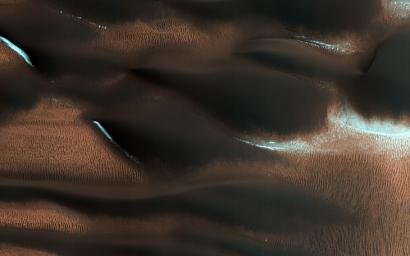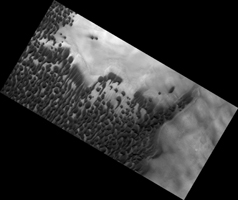
|
Aeolian Features of Scandia Cavi
- Click the image above for a larger view
- Full-Res JPEG (2880 x 1800) (693.2 kB)
- Full-Res TIFF (2880 x 1800) (13.6 MB)
Caption:

Map Projected Browse Image
Click on the image for larger version
This HiRISE image shows modified barchan dunes with shapes that resemble "raptor claws." The unusual morphology of these dunes suggests a limited supply of windblown sand.
Winds likely blew from the northeast resulting in elongate dunes with an asymmetric downwind point. The transverse crests of the smaller ripples/mega-ripple bed-forms surrounding the dune, echo the dominant downwind direction towards the southwest.
This locality is in the Northern Lowlands directly east of Dokka Crater in Scandia Cavi.
Background Info:
The University of Arizona, Tucson, operates HiRISE, which was built by Ball Aerospace & Technologies Corp., Boulder, Colo. NASA's Jet Propulsion Laboratory, a division of the California Institute of Technology in Pasadena, manages the Mars Reconnaissance Orbiter Project for NASA's Science Mission Directorate, Washington.
Cataloging Keywords:
| Name | Value | Additional Values |
|---|---|---|
| Target | Mars | |
| System | ||
| Target Type | Planet | |
| Mission | Mars Reconnaissance Orbiter (MRO) | |
| Instrument Host | Mars Reconnaissance Orbiter | |
| Host Type | Orbiter | |
| Instrument | High Resolution Imaging Science Experiment (HiRISE) | |
| Detector | ||
| Extra Keywords | Color, Crater, Dune, Map | |
| Acquisition Date | ||
| Release Date | 2015-09-30 | |
| Date in Caption | ||
| Image Credit | NASA/JPL-Caltech/Univ. of Arizona | |
| Source | photojournal.jpl.nasa.gov/catalog/PIA19962 | |
| Identifier | PIA19962 | |
